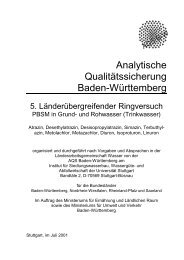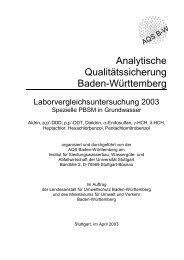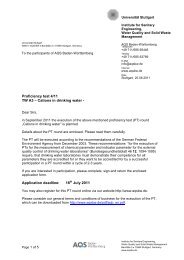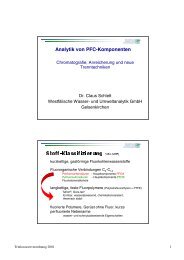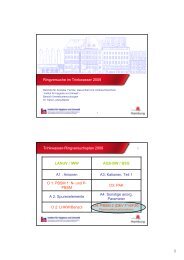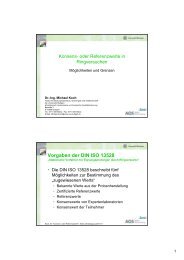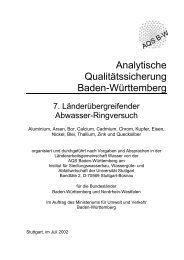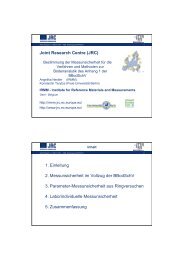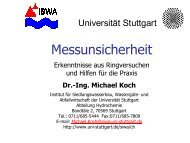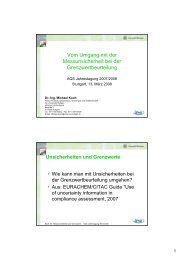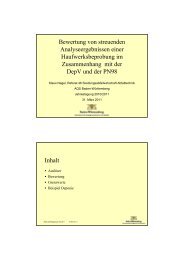Institute for Sanitary Engineering, Water Quality and Solid Waste ...
Institute for Sanitary Engineering, Water Quality and Solid Waste ...
Institute for Sanitary Engineering, Water Quality and Solid Waste ...
Create successful ePaper yourself
Turn your PDF publications into a flip-book with our unique Google optimized e-Paper software.
Chair of <strong>Waste</strong> Management <strong>and</strong> Emissions<br />
phase, both useful <strong>and</strong> harmful interactions between<br />
the components were diagnosed <strong>and</strong> set up in a Reverse<br />
Functional Model. That model was visualised by<br />
the Interaction Matrix. Based on the Reverse Functional<br />
Model, several optimisation strategies such as problem<br />
elimination, cost reduction or value increasing<br />
were discussed. The optimisation was done according<br />
to the value increasing strategy. Embedding computer-aided<br />
ergonomic design (CAED) allowed avoiding<br />
ergonomic failures, which were identified during the<br />
testing of the robot.<br />
The per<strong>for</strong>mance of a biomass processing greenhouse<br />
robot <strong>for</strong> autonomous h<strong>and</strong>ling of biomass in solar<br />
dryers was investigated. Power consumption <strong>and</strong> specific<br />
energy dem<strong>and</strong> were registered during various<br />
field tests. Applying 3D laser scanning, the effects of<br />
the rotary tiller type tool on the transportation capacity<br />
were investigated. An empirical model describing<br />
these effects was developed. For efficient motion control,<br />
six motion strategies <strong>for</strong> the robot were developed.<br />
Each of the corresponding trajectories consists<br />
of more than 1,300 three-dimensional coordinate<br />
points. The motion strategies were evaluated due to<br />
their efficiency to select the most promising one <strong>for</strong><br />
being embedded into the control system of the robot.<br />
For evaluation, an algorithm was developed calculating<br />
different evaluation parameters such as total cycle<br />
time, covered distance <strong>and</strong> no-load time. The best<br />
strategy was recommended <strong>for</strong> being embedded into<br />
the control system of the robot.<br />
In conclusion, the adapted <strong>and</strong> extended VDI design<br />
procedure, which was presented in this work, supported<br />
rapid development of an innovative <strong>and</strong> costefficient<br />
robot. In addition, it delivered a consistent<br />
documentation that allows tracing all decisions made<br />
during the product development. For the testing phase,<br />
which is up to now not a part of the classical VDI<br />
design method, the presented optimisation approach<br />
proved to be uncomplicated, clear <strong>and</strong> compatible to<br />
the VDI design procedure. In combination with CAED it<br />
could contribute to develop highvalue <strong>and</strong> user-friendly<br />
products. Regarding the control design of the robot,<br />
3D laser scanning helped to identify rapidly optimum<br />
parameter settings <strong>for</strong> maximum transportation capacity<br />
of the robot. Finally, 3D path planning led to optimised<br />
motion paths <strong>and</strong> there<strong>for</strong>e to reduction of cycle<br />
time of the whole process of drying biomass.<br />
Furthermore, by now a technology is provided, which is<br />
suitable <strong>for</strong> application in industrial scale such as processing<br />
of biowaste or residues from biogas plants.<br />
Doctoral c<strong>and</strong>idate: Nikica Starčević<br />
Principal examiner:<br />
Prof. Dr.-Ing. Martin Kranert<br />
Secondary examiner:<br />
Prof. Dr. Joachim Müller<br />
Nikica Starčević<br />
Systematic design <strong>and</strong> process optimisation of<br />
a robot <strong>for</strong> treatment of biomass in solar<br />
dryers (2009), Forschungs- und Entwicklungssinstitut<br />
für Industrie- und Siedlungswasserwirtschaft sowie<br />
Abfallwirtschaft e.V. Stuttgart (FEI). München: Oldenbourg<br />
Industrieverlag GmbH, 2009. (Stuttgarter Berichte<br />
zur Abfallwirtschaft; Bd. 95), 150 S., 58 Abb.,<br />
13 Tab., ISBN 978-3-8356-3186-1<br />
“International Kitzbühler <strong>Water</strong> Prize“ <strong>for</strong><br />
Mr. Nikica Starcevic<br />
Mr. Nikica Starcevic was granted the degree of doctor<br />
with his excellent dissertation, which on 14 th October,<br />
2009 won him the first place (3000€) in “International<br />
Kitzbühler <strong>Water</strong> Prize“ under the program Kitzbühler<br />
<strong>Water</strong> Price 2009.<br />
Mr. Starcevic’s Phd. dissertation is entitled „Systematic<br />
design <strong>and</strong> process optimization of a robot <strong>for</strong><br />
treatment of biomass in solar dryers”, which is under<br />
the cooperation project between the <strong>Institute</strong> <strong>for</strong><br />
<strong>Sanitary</strong> <strong>Engineering</strong>, <strong>Water</strong> <strong>and</strong> <strong>Waste</strong> Management<br />
at the University of Stuttgart (Prof. Kranert) <strong>and</strong> the<br />
<strong>Institute</strong> of Agricultural <strong>Engineering</strong> at the University<br />
of Hohenheim (Prof. Müller). Mr. Starcevic graduated<br />
with distinction in the spring of 2009 at the Faculty<br />
of Civil <strong>and</strong> Environmental <strong>Engineering</strong>, University of<br />
Stuttgart. Since the summer of 2009 Dr. Starcevic has<br />
been working as the project leader in a consulting firm<br />
<strong>for</strong> environmental technologies.<br />
In general, the development of the mixing <strong>and</strong> transporting<br />
robot contributed to increased automation level<br />
of solar <strong>and</strong> solar assisted drying systems. From<br />
now the solar drying technology possesses a fully automated<br />
processing robot <strong>and</strong> the competitiveness to<br />
conventional systems will be enhanced significantly.<br />
65




